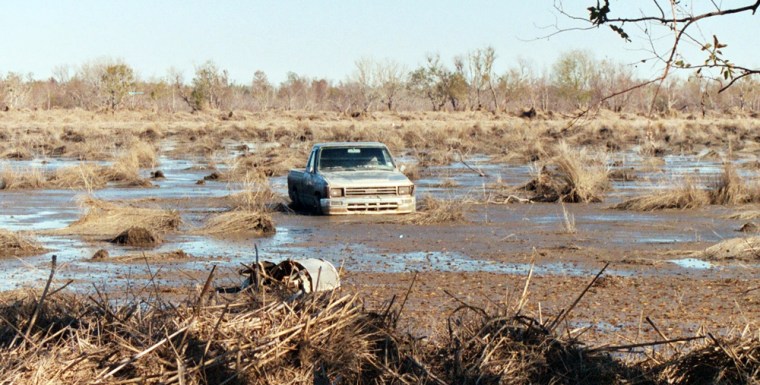With Hurricane Katrina still a recent memory, Congress is mulling over several bills to restore Louisiana’s vanishing coastal wetlands. Much of the money would go to large engineering projects that would divert water from the Mississippi River and its tributaries.
But a new study suggests that hurricanes themselves can do the job the projects are intended for, which is to spread new sediment across wetlands. The researchers estimated how much sediment Hurricanes Katrina and Rita washed ashore in 2005 and have concluded that hurricanes could supply all the silt and other inorganic sediment that healthy wetlands in this region need.
These conclusions will probably “raise some eyebrows among people in favor of river diversions,” said Eugene Turner of Louisiana State University, who is the lead author of the study. The research appears online Thursday at the journal Science’s website, Science Express. Science is published by AAAS, the nonprofit science society.
The wetlands of southern Louisiana make up the largest wetlands system in the United States. According to a recent report by the National Academy of Engineering, the region provides 1 billion pounds (455 million kilograms) of seafood and 25 percent of the nation’s oil and gas each year. The wetlands are also thought to protect inland areas by providing a buffer against storm surges.
Sand, silt, clay and other inorganic sediments make up a relatively small portion of wetlands, but they are nonetheless important for building the physical framework underneath the plants.
Louisiana’s coastal wetlands have been disappearing since the 1950s, though the rate has slowed since 1990. Many researchers and environmentalists have focused on the levees that steer the river straight down to the ocean, preventing it from periodically spilling over its banks and rearranging its course. Left to its own devices, the river would slowly deliver inorganic sediment at various points across the landscape, but now the wetlands don’t receive this supply.
Exactly which changes are most responsible for the wetlands’ decline is still up for debate, however. Although levees have received a lot of attention, not all researchers are convinced that river overflow is essential for wetland health.
Canal dredging, sinking of the land due to gas and oil drilling, and the introduction of a plant-demolishing rodent called the nutria have also contributed to the damage.
And then there’s the matter of hurricanes, which has been “left out of the discussion” until now, Turner said.
Mississippi mud
The Army Corps of Engineers is concentrating its wetland restoration efforts on emulating the river’s natural flooding process. The engineers have built “leaks” into the levees in a couple of spots, where water can spill out and drop sediment onto the land. One downside to this approach is that the water only carries the sediment so far.
“The shape of the deposit is kind of like a lollipop,” said Turner.
The Corps has proposed more large-scale river diversion projects, which would cost hundreds of thousands of dollars for every acre of wetland restored, according to Turner.
The assumption behind these projects is that river overflows are chiefly responsible for delivering inorganic sediments to wetlands. After Hurricane Katrina and then Rita struck in 2005, Turner saw an opportunity to test this assumption.
Once the flooding had receded, a new layer of mud blanketed the wetlands of southern Louisiana. The new mud, about 2 inches (5 centimeters) thick, on average, was easy to distinguish.
“It was just visually obvious. It had no debris, and then underneath you’d find what you’d normally find in a marsh. We saw whole green leaves buried by this mud,” Turner said.
Turner’s research team took samples of the muddy sediment layer from locations across southern Louisiana and Texas, using a helicopter to cover as much ground as possible. Based on their measurements, they estimated how much inorganic sediment was carried ashore by the two hurricanes. Then they compared their results with other published estimates of the sediment volumes delivered by river diversion.
An answer blowing in the wind?
Together, Katrina and Rita delivered about 130 million tons of inorganic sediment to the Louisiana coast, the authors concluded.
If the estimates the researchers used for comparison are correct, that means that the amount of sediment delivered to wetlands by hurricanes is roughly five times as much as was delivered by natural river flooding before the levees were built. And it’s about 200 times the amount that planned river diversions would deliver.
These results apply to hurricanes that fall into category 3 or higher on the intensity scale. Such hurricanes have historically hit the Gulf Coast once every eight years or so, on average, according to Turner.
“We’ve had hurricanes forever and the coast was still built. Hurricanes can’t be seen as totally beneficial or totally devastating. They’re just part of the system,” Turner said.
Part of the reason that hurricanes are so effective at delivering sediment is that they cover much larger areas than the lollipop-shaped areas reached by river diversions.
“Hurricanes are more democratic. They spread sediment out all over the coast,” Turner said.
More research will be necessary to determine where the sediment in this layer was before it was deposited by the hurricanes. One concern is that hurricanes may be simply moving material from one wetland location to another.
There are still many ways that humans can help restore Louisiana’s wetlands, Turner said. He suggested filling in the canals dredged by oil and gas companies, creating much smaller river diversions, and restoring the natural drainage channels on an acre-by-acre basis.
